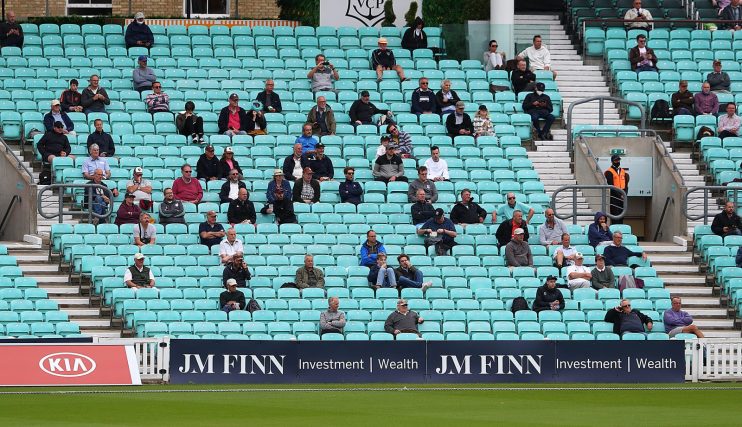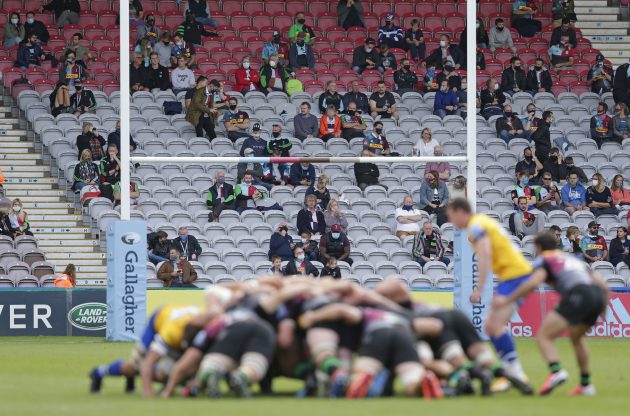Surrey and Harlequins welcome return of fans but warn that capacity limits will lose clubs more money

Two of English sport’s biggest clubs have welcomed the imminent return of fans but warned that staging matches with restricted capacity is not financially sustainable.
Spectators will be able to attend live sport in limited numbers when the country’s second lockdown is lifted on 2 December, it was announced on Monday.
The move is a welcome boost for sports clubs and organisations financially battered by the pandemic, which has kept most stadiums shut since March.
“We found it very promising news indeed, because there has been a disconnect in the system so far,” Surrey cricket chief executive Richard Gould told City A.M.
Surrey successfully staged two matches with limited capacity at The Oval earlier this year, a two-day friendly with Middlesex in July and a T20 Blast contest against Hampshire in September.
But the government shut down stadiums again later that month, amid a rise on Covid-19 cases, yet shops, cinemas and theatres remained open until October.
“There were times during the summer when the frustration of not being able to get supporters in did hit its peak,” Gould added.
“The trials we ran here went extremely well, they were delivered in a very safe manner and people were very confident about coming in. They then stopped, unfortunately. And it did feel strange.”
Not a sustainable model
The Oval holds 25,500 but Surrey were limited to 1,000 spectators a day for the Middlesex friendly and 2,500 for the rain-affected T20 win over Hampshire.
Up to 4,000 fans will be allowed to attend live sport from next week in low-risk Tier 1 areas, and up to 2,000 in medium-risk Tier 2.
“Opening up a stadium of any significant size for either 2,000 or 4,000 supporters is going to lose money,” said Gould.
“It will not make economic sense but you’ve got to start somewhere, and we’re not going to go from zero to 100 per cent crowds overnight.
“So I think venues are likely to absorb the cost, demonstrate that it can be done and then they will want to rapidly get those numbers up to a level which would at least cover its costs.”
Rugby club Harlequins had around 2,800 spectators at The Stoop for a Premiership defeat to Bath in early September as part of a pilot scheme.
“The top line is, that’s not a sustainable model. These 2,000 crowd limits aren’t either,” Quins chief marketing officer Adrian Wells told City A.M.

“We did make a small profit if you just include the operational costs of that individual match. But nowhere near, about 10 per cent, of what we’d normally make on a match day.
“That’s not sustainable if you multiply out across a season and start to overlay the club’s running costs, the salaries of staff and players, a training ground. It’s not financially viable.”
Stadiums ‘aren’t plug and play’
Staging a match in a manner that maintains social distancing and ensures a safe environment comes with additional costs, both clubs said.
“It’s not just the stewarding costs on the day. Many of these stadia haven’t been used for a long time so they need to be brought back into use,” added Gould.
“Toilet facilities, floodlights, PA systems – all these things need to be recommissioned, so it’s quite a big logistical exercise to get these things turned on again.
“A stadium isn’t a plug and play. I’d say anything below 50 per cent [attendance] and you’re struggling to cover your costs.”
Clubs are happy to have supporters back even if it means a short-term financial hit, however, and there is hope that capacity will be allowed to gradually increase.
“As long as we’re on the road to grow, we think this is now giving our season ticket holders a chance to be part of match days,” said Wells.
“We can see light at the end of the tunnel. This isn’t the end point, clearly, but it’s in the right direction.”
Back to normal by Easter?
With cricket in hibernation for now, Gould says he is “cheering on football and rugby so they can do their bit and get the numbers up over the next few months, and hopefully be back to normal by Easter”.
But the Surrey boss has called for more clarity on what it will take – in terms of infection rates or otherwise – for restrictions to be eased further.
“That kind of clarity would help people understand why a shopping centre can be open but a sports stadium not,” he said.
“We’ve all been prepared to take one for the team over the last seven or eight months and accept that, frankly, there have been inconsistencies.
“But now we can see a horizon where we can get through, those inconsistencies need to be dealt with.”
